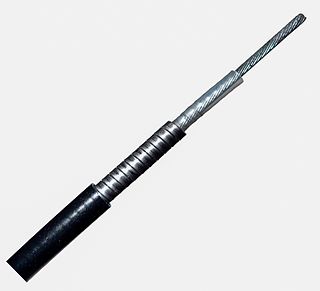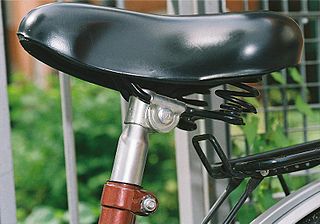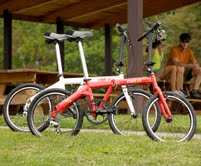
A Bowden cable is a type of flexible cable used to transmit mechanical force or energy by the movement of an inner cable relative to a hollow outer cable housing. The housing is generally of composite construction, consisting of an inner lining, a longitudinally incompressible layer such as a helical winding or a sheath of steel wire, and a protective outer covering.
Top Hat 25 is a series of English designed yachts made in Australia from 1964 to 1986. It came in four different 'marks' (models) named Mk 0 - III. After the Mk III, another model, the Top Hat 27, was launched in 1986.

The Raleigh Chopper is a bicycle for children / young adults, manufactured and marketed by the Raleigh Bicycle Company of Nottingham, England. The unique design became a cultural icon and is fondly remembered by many who grew up in that period. The design was influenced by dragsters, "chopped" motorcycles, beach buggies, and even chariots, as can be seen on the centre page of the 1969 Raleigh US catalogue. The bicycle has featured in many movies and TV series. MK1 models were produced from 1968 to 1972, MK2 models were produced from 1972 to 1983 and MK3 models were produced from 2004 to 2012 and sold through to 2018.

The Birdy is a folding bicycle designed by Riese und Müller in Germany and produced by Pacific Cycles in Taiwan. As of 2010 over 100,000 had been sold. Three distinct models have been marketed, in addition to some specialist variations, with the third (Mk3) introduced in July 2015.

A bicycle seatpost, seatpin, saddlepole, saddle pillar, or saddle pin is a tube that extends upwards from the bicycle frame to the saddle. The amount that it extends out of the frame can usually be adjusted, and there is usually a mark that indicates the minimum insertion. Seatposts can be made of steel, aluminum, titanium, carbon fiber, or aluminum wrapped in carbon fiber.

The Volkswagen Golf Mk2 is a hatchback, the second generation of the Volkswagen Golf and the successor to the Volkswagen Golf Mk1. It was Volkswagen's highest volume seller from 1983 and ended in (German) production in late 1992, to be replaced by the Volkswagen Golf Mk3. The Mk2 was larger than the Mk1; its wheelbase grew slightly, as did exterior dimensions. Weight was up accordingly by about 120 kg (260 lb). Exterior design, developed in-house by VW design director Schäfer, kept the general lines of its Giugiaro-designed predecessor, but was slightly more rounded. All told, about 6.3 million second-generation Golfs were built.

The Bickerton, also called the Bickerton Portable, was a portable aluminium folding bicycle designed by Harry Bickerton and manufactured in the UK and Australia between 1971 and 1989. Bickerton, an accomplished engineer, suffered a three-year driving ban for drunk driving in 1970 following a car crash, and invented the bike for himself, to be carried onto public transport or stored in the trunk of a car as small as an Austin Mini.
The Raleigh Bicycle Company is a British bicycle manufacturer based in Nottingham, England and founded by Woodhead and Angois in 1885. Using Raleigh as their brand name, it is one of the oldest bicycle companies in the world. After being acquired by Frank Bowden in December 1888, it became The Raleigh Cycle Company, which was registered as a limited liability company in January 1889. By 1913, it was the largest bicycle manufacturing company in the world. From 1921 to 1935, Raleigh also produced motorcycles and three-wheel cars, leading to the formation of Reliant Motors. Raleigh bicycle is now a division of the Dutch corporation Accell.

The stem is the component on a bicycle that connects the handlebars to the steerer tube of the bicycle fork. Sometimes called a goose neck, a stem's design belongs to either a quill or threadless system, and each system is compatible with respective headset and fork designs:

A bicycle handlebar is the steering control for bicycles. It is the equivalent of a tiller for vehicles and vessels, as it is most often directly mechanically linked to a pivoting front wheel via a stem which in turn attaches it to the fork. Besides steering, handlebars also often support a portion of the rider's weight, depending on their riding position, and provide a convenient mounting place for brake levers, shift levers, cyclocomputers, bells, etc.
The Raleigh Burner is a BMX bicycle first launched in early 1982 by the Raleigh Bicycle Company. The name continued to 1988 and was brought back in the early 2000s, although it has been nowhere near as successful saleswise as the 1980s item.
The Raleigh Strika was a children's bicycle manufactured between 1976 and 1983 by the Raleigh Bicycle Company of Nottingham, England. It was part of the Action Bikes range, smaller in size than the Grifter but larger than the Boxer, with frame dimensions designed to accommodate 6 to 10 year olds.
The Raleigh Dirt Cross was a children's bicycle manufactured from 1996-1999 by the Raleigh Bicycle Company of Nottingham, England.

The following outline is provided as an overview of and topical guide to bicycles:

Melon Bicycles was a folding bicycle manufacturer based in Chapel Hill, North Carolina. Many cyclists refer to the company as Melon Bikes, Melon Bicycles, or simply Melon. Melon Bicycles went out of business in 2014.

A wheelie bike, also called a dragster, muscle bike, high-riser, spyder bike or banana bike, is a type of stylized children's bicycle designed in the 1960s to resemble a chopper motorcycle and characterized by ape hanger handlebars, a banana seat with sissy bar, and small wheels. Notable examples include the Schwinn Sting-Ray and Krate lines and the Raleigh Chopper line. Other notable manufacturers and retailers that offered models include AMF, CCM, Columbia, Huffy, Iverson, J. C. Penney, Malvern Star, Monark, Murray, Ross, Sears, and Vindec.
Diamondback Bicycles is an American bicycle brand that is based in Kent, Washington. Diamondbacks are sold in many countries, including the United States, Australia, Canada, and the United Kingdom. Most Diamondbacks are considered to be mid-type bicycles, with a high-end prototype in development as of 2011. Diamondback is owned by global private equity firm Regent, L.P., which also owns Redline Bicycles.
The Raleigh Bomber was a bicycle aimed at the boys/youth market which first appeared in 1981. The Bomber had wide balloon tyres, a low slung frame and a sprung saddle with wide "cowhorn" style handlebars in the general style of a "cruiser" bicycle.










